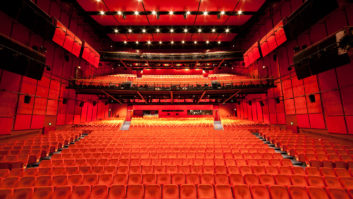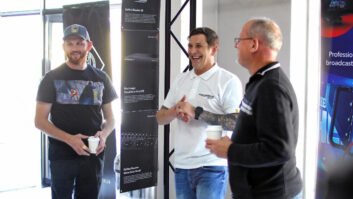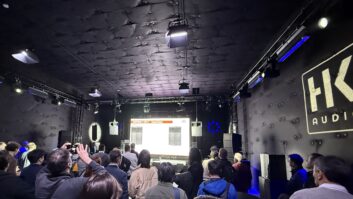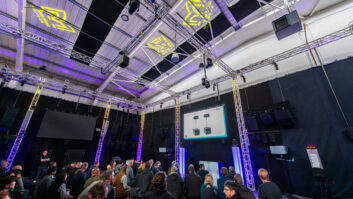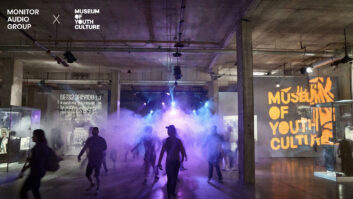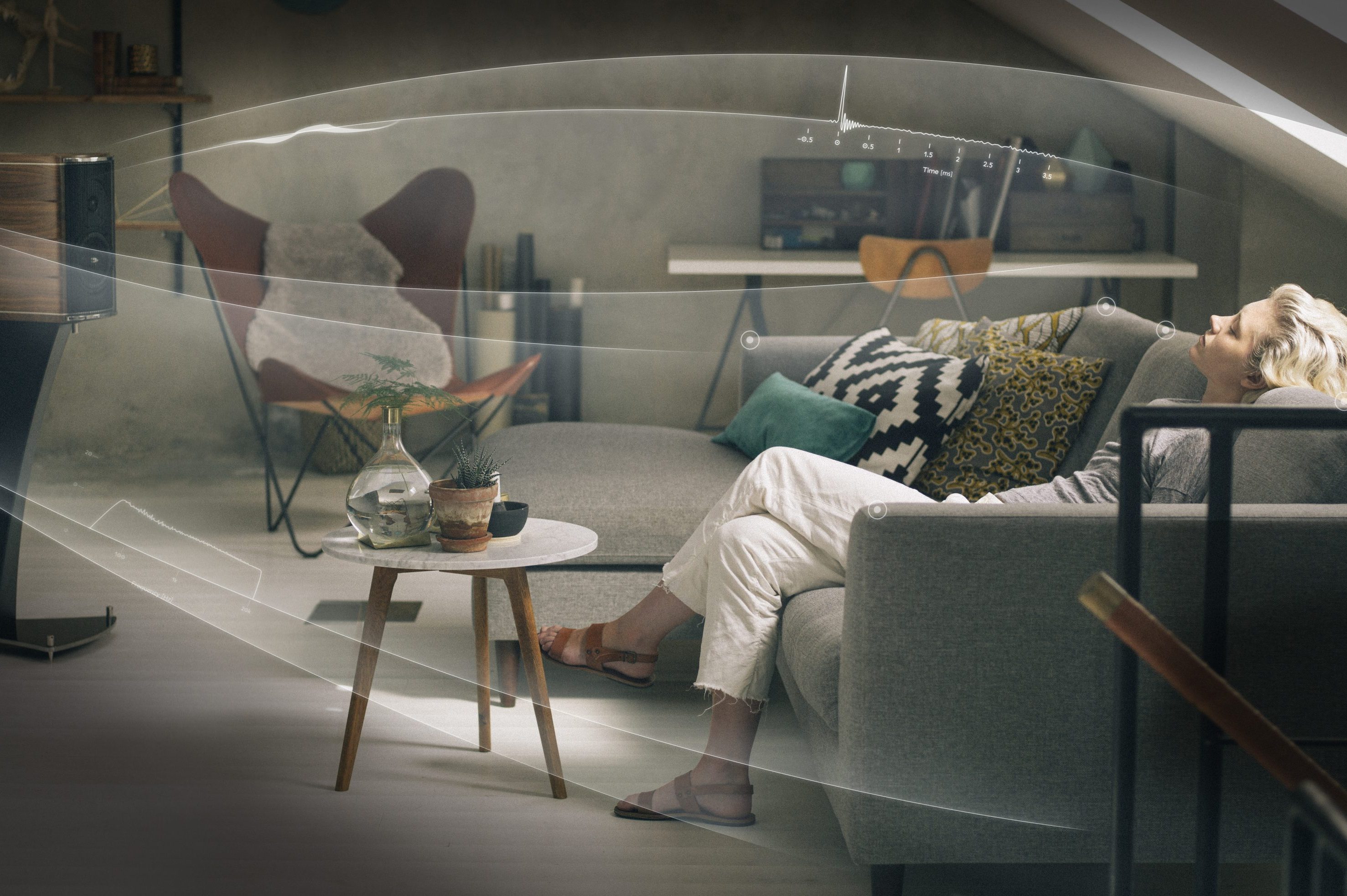
A number of companies have been working on 3D or immersive audio for some time – and now the technology is on the verge of breaking through to the mainstream, says Tim Frost.
There is something of a buzz around immersive or 3D audio. The term can be used for a wide range of concepts and technologies from cinema ‘surround’ to variations on architectural audio; it’s not something that can be pinned down to any one specific approach.
We are at an early stage in immersive’s introduction into non-cinema sound installations, but those involved already say that it will eventually become the norm for sound installations in entertainment venues: theatres, rides, clubs, exhibitions and attractions.
With immersive, spatial sound design moves a step forward as a creative tool. This is not about the traditional sound installation’s concerns of delivering good-quality sound consistently to as many of the audience as possible (although a spin-off effect of an immersive install would be improvements in coverage). Instead it is about offering new creative tools to sound designers.
For some, immersive audio seems to be inextricably linked to the concept of object-oriented sound, but this is not necessarily the case. To put it as simply as possible, the traditional channel-based sound chain has the source material recorded in five, seven, nine or more separate channels (the standards introduced by cinema). The mix is delivered on a multi-channel carrier and fed to the auditorium speaker system to drive front of house or screen and surround effects.
In contrast, object-oriented audio stores each of the sound objects – a singer’s or actor’s voice, an instrument or a specific effect – and adds metadata to it that describes where it should be in the auditorium. In playback, the processor takes the metadata and in real time places the sound object to the speakers at those positions.
In reality, live immersive will be using a hybrid of channel-based and object-based sound designs. Being able to work with channel- or object- based sources should not a huge issue for installers, as long as everyone can be sure that the immersive sound processors can translate, convert or map the sound sources into the right places in the auditorium.
There seems to be no worry about the ability of today’s processors to handle immersive’s heavy-duty DSP work across multiple channels. “There is absolutely the power available,” says Steve Ellison, applications director of digital products at Meyer Sound.
Ron Bakker, systems marketing manager at Yamaha Commercial Audio Systems Europe, agrees: “The hardware is more secure and the processing is so powerful and so cheap that we don’t need to worry about that any more.”
Gregor Zielinsky, senior manager research & innovation at Sennheiser, also agrees, but notes that latency caused by the processing is one aspect that needs consideration. “Nowadays, the majority of modern mixers meet the needs of minimum latency; however, it is still an important consideration if you are doing live music where low latency is imperative,” he says.
Bjorn Van Munster, director of Astro Spatial Audio, says that latency should not be an issue. “The hardware is very robust and at present in our standard configuration we are at a latency of 5ms; we can configure that down to 3ms.”
Film heritage
To understand the importance of the creative drive for immersive, think in terms of the film industry. This took to immersive (aka surround) sound decades ago as a creative tool for positioning effects all around the auditorium to increase audience enjoyment. Live events – from musicals to park attractions, rock shows, theatre, clubs and corporate launches – could make even more creative use of controlling sound around the audience, provided the installations are in place to play them out.
IOSONO, now part of Barco, has the complete chain, from playout processors to production tools to ensure designers can create imaginative soundscapes in the first place.
“My experience is that a project is only successful where there is a strong creative idea behind it,” says IOSONO pro audio strategic marketing manager Stephan Mauer. “The object-based content required to drive these to their full potential is created in our Spatial Audio Workstation that lives in Steinberg’s Nuendo and can be linked to ProTools.”
The cinema market gives a clue to the way that the live market may well develop. Dolby’s flagship Atmos started at the top end of the market, but this is already changing, says Dolby technical marketing manager Nick Watson.
“At the start Atmos went to the high-profile early adopters, but over time we are seeing multiplexes’ Screens 2 and 3 being installed. It is these screens that have helped drive the local content as they know it will get played in Atmos. So as more regular venues get installed, then more productions will be designed in immersive,” says Watson.
Uwe Cremering, director of AMBEO immersive audio at Sennheiser, says: “We believe in 3D audio, and having 3D for live will make sense as a business case. There are investments in this, and we have met smart club owners, for example, who want to bring in 3D audio as soon as possible. Making it a mainstream is a challenge but it is already moving that way.”
At Meyer Sound, Ellison is already seeing immersive move away from being exclusively for first adopters: “It started off with sound design pioneers, now there are lot more shows trying it. We are seeing this in corporate work, with corporate theatres that have adjustable acoustics and multichannel playback and moving the sound in space.”
Van Munster agrees: “We are on the edge of mainstream adoption – it’s now a matter of time.”
Complete chain
Sennheiser sees immersive as being so important that it has set up the Ambeo division to deliver the complete immersive chain, from its ambisonics microphone through to processors and speakers. “Over five years ago we started thinking about solutions for the market,” says Zielinsky. “If we wanted to be a driver for this, we knew we would need to look at it holistically, from recording to the mixing and to the listening.”
Without a doubt, installing immersive audio systems is a costly business, with additional speakers at higher quality, the infrastructure wiring to each individual speaker and of course the immersive processors. But costs are going down, with the take-up in the cinemas having a knock-on effect for the wider market.
Dolby’s Watson explains: “We have seen the costs going down partially because installers have more experience in installing them and partially because speaker manufacturers have developed new higher-power speakers with more overhead mounting flexibility and the availability of new multi-channel amplifiers.”
Even so, the big installs will remain at the top end for a while, says Van Munster: “I don’t expect the costs to change dramatically in the near future; the market is not that big.”
The upside of that is a higher value for the installer and manufacturers, notes Bakker. “Of course it will sell more speakers and amplifier channels,” he says. Yamaha’s mixers, amps, desks and processors would most likely appear somewhere in an immersive system and these should be able to interface properly already, he notes. “Our network infrastructure of speaker processors are all based on Dante control and our mixers can accept multi-channel audio from almost all of the systems in existence.”
However many multi-purpose venues, such as regional theatres, are already one step towards the immersive concept with their electronic architectural acoustic systems. Coping one day with a talk or a play which needs low reverb times and the next day with a concert where a dry sound would kill the performance, some have installed electroacoustic systems such as Meyer Sound’s Constellation or Yamaha’s AFC3, which use an array of microphones and dedicated speakers throughout the auditorium to tailor the acoustics at the touch of a button.
www.astroaudio.eu
www.dolby.com
www.iosono-sound.com
www.meyersound.com
www.sennheiser.com
www.yamahaproaudio.com
